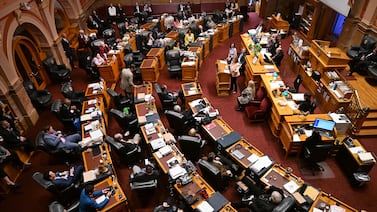Sign up for Chalkbeat Chicago’s free daily newsletter to keep up with the latest news on Chicago Public Schools.
Courtney Billittier comes from a long line of educators, including her father who recently retired after 35 years of teaching. But Billittier, who has been teaching for the past 14 years, will have to work longer than her father to earn a smaller pension.
That’s because state lawmakers passed pension reform legislation to deal with a budget crisis in 2010 that created new standards for public sector employees hired at the start of 2011. The result is a two tiered pension system: Employees hired before 2011 were able to retire as early as age 55 and with more financial perks, while employees hired after that year were eligible to retire at age 67. This is often referred to as Tier 1 and Tier 2 benefits.
Billittier said her father has always encouraged her to have a separate retirement savings account because of the change in state law.
“I think it really ingrained in me right away that I should not be banking on the pension at the end of this career being something that I can live off of entirely, and that there has to be some actions that I’m taking on my own,” said Billittier.
Teachers unions, including the Illinois Federation of Teachers and Illinois Education Association, alongside other public sector employee unions are advocating for state lawmakers to make a change to retirement benefits for newer educators. They say it is unfair to current educators who pay the same amount into the pension system but do not receive the same benefits and have to work longer. They also fear that the current system will deter new educators from entering the profession at a time when the state is struggling with a teacher shortage.
But there’s an even bigger issue: The lower tier retirement benefits could soon fall below what is provided by Social Security.
In Illinois, public school educators and other public sector employees do not pay into Social Security and are also not eligible to receive those federal benefits when they retire. Still, Illinois must ensure that benefits are at least equal to Social Security.
The Civic Federation, a nonpartisan research organization, said state lawmakers will have to make a change to the tiered retirement benefits soon or the state will risk falling out of compliance with federal laws, known as Safe Harbor — a standard set by the Internal Revenue Service assessing several factors to see if state pension benefits are equivalent to Social Security benefits — which could be costly for Illinois.
Illinois Sen. Robert Martwick, who has proposed legislation in the past and this year to change the teacher retirement benefits system, said it could get expensive for the state, local municipalities, and even school districts if the state’s pension systems do not comply with federal law. Martwick said the lower tier pension benefits could open school districts up to costly lawsuits — if teachers prevailed, settlements could eat into districts’ operating budgets.
“That would sink Illinois overnight,” said Martwick, adding that failing to correct the situation is not an option for the state.
Teachers unions, state legislators, and finance experts all agree that the lower tier pension benefits need to be addressed. However, they differ in how to fix the problem. Here are five things you should know about Illinois’ two tier pension benefits and what they mean for educators and classrooms.
Why did Illinois create a second tier pension benefit?
State pension funds were hit hard by the 2008 financial crisis, often called the Great Recession, since pension systems have investments in the stock market. Public pensions across the nation saw their investments fall in value by $889 billion between 2007 and 2008, according to numbers by the Federal Reserve.
Amanda Kass, assistant professor at DePaul University, said the health of the pension system determines how much money the state and employees must contribute to the system in order for it to have money to pay retirees. When the market crashed, the amount Illinois lawmakers needed to contribute went up significantly. To help offset ballooning pension payments, state lawmakers passed a bill in 2010 that changed retirement benefits for all public sector employees who started working on or after Jan. 1, 2011. They believed the plan would save the state money over time.
Annie Rojas, lead policy analyst at the Center for Tax and Budget Accountability, said the state’s pension problems started before 2010. She pointed to policy changes in 1995 under Republican Gov. Jim Edgar when the state created a pension ramp, known as the Edgar Ramp, that would require the state to get pension funds to 90% funded by 2045. This ramp set the state’s pension contributions very low at the beginning of the 50-year plan, leading to higher pension costs later on. According to Crain’s Chicago Business in 2010, the state was not contributing enough funding to the pension system even before Edgar’s Ramp was created. Since the 1980s, lawmakers have cut funding to pensions to deal with budget shortfalls.
Pension payments make up almost 20% of the state’s proposed budget for fiscal year 2026. The Teachers Retirement System’s funded ratio is at 45.8% as of fiscal year 2024.
What do Tier 2 pension benefits mean for educators?
All pension funds in Illinois have two tiers now. This includes the Teacher Retirement System, which covers all teachers in the 800-plus school districts outside of Chicago, and the Chicago Teachers Pension Fund.
Al Llorens, president of the Illinois Education Association, said a key difference between the two tiers is that teachers in the second tier must work until age 67. For educators who might have started as a teacher right out of college at the age of 22, they will have to work about 45 years. However, teachers in the first tier could receive retirement benefits at age 55, having worked for roughly 33 years.
Once teachers in Tier 2 retire, their pensionable salary is capped and calculated differently than Tier 1 teachers. That calculation takes their highest salary of eight years in the 10 years before retiring, rather than four of the last 10 years, which results in a lower final average salary, according to the Civic Federation.
Regardless of the difference in benefits between the two tiers, all teachers pay the same amount into the pension system, which Llorens said is leading teachers to leave the profession.
“If you’re paying a lot more than what your pension is returning, that’s not an incentive to stay either,” said Llorens. “We do have to deal with something that not only allows us to attract but to retain teachers, because we’re in the middle of a shortage that doesn’t seem to be going away anytime soon.“
Could smaller retirement benefits steer people away from the profession?
It’s unclear whether smaller retirement benefits are steering people away from the teaching profession in Illinois. However, finance experts, educators, and teachers union leaders believe it could be an issue for hiring and retaining educators.
Tom Moore, a science teacher at Hoffman Estate High School at Township School District 211, who is in Tier 2, said he thinks it could be hard to retain some educators who might not have realized they were going to have to work longer than some of their colleagues.
“I’m 13 years in now, and I still have 35 more years to go,” said Moore. “At this point, if I was Tier 1, I would already be a third away or almost half the way through my professional career.”
Hiring and retaining teachers are a major concern for local school districts, especially since the state is dealing with a teacher shortage. A joint report from the Illinois Association of Regional Superintendents of Schools and the Illinois State Board of Education found that the shortage of teachers is easing across the state, but it has been difficult for districts to fill certain teacher positions, such as roles in special education and bilingual education.
When education leaders were asked about the top three issues leading to teacher shortages, 143 of the 694 leaders who responded said it was due to difficulty hiring and retaining teachers, according to the report.
“While the pay during their career may not be great there was always a good retirement to work towards,” said a quote in the report. “Now they don’t have either.”
Can the state undo its two tiered pension system?
The short answer is probably not. It would be expensive for the state to put all of its teachers and other public sector employees into Tier 1.
Pension costs for the state are already high: In fiscal year 2025, pensions accounted for roughly 19% of the state’s overall operating budget. According to a report by the University of Illinois’ Institute of Government and Public Affairs, it would cost the state almost $30 billion by fiscal year 2045 to match Tier 2 retirement benefits to Tier 1. This would require the state to add $1.3 billion dollars to pensions by the end of 2027.
Annie McGowan from Civic Federation said the state does not “have the revenue stream” to make larger payments to the pension system. Especially at a time when there are other pressures on state funding.
Illinois’ pension system also could be affected by the dramatic decline in the stock market that has followed President Donald Trump announcing tariffs, or taxes on goods from other countries, last week. The last time the market took such a hit was at the beginning of the COVID pandemic in 2020.
What are the proposals to change Tier 2?
State lawmakers, teachers unions, finance and budget officials, and even Gov. J.B. Pritzker have different ideas for how to improve the teacher pension system. But they all agree that the main constraint is cost.
The Civic Federation called on the state in a report from 2023 to comply with federal laws and ensure the second tier remains equal to or better than Social Security benefits. Rojas, from the Center for Tax and Budget Accountability, said compliance with federal law isn’t enough when the difference in pension benefits between tiers is inequitable for workers.
The Illinois Educators Association would like to see the retirement age for Tier 2 workers reduced from 67 to 60 years old — still more than workers in the first tier — and an increase in retirement benefits, said Llorens.
State lawmakers filed House Bill 2711 and Senate Bill 2 to change part of Tier 2 in this spring’s legislative session. Martwick said his proposal in the Senate will ensure that the state is in compliance with federal law and will make some changes requested by state employee unions. However, he said the bill is likely to change before being voted on since there are ongoing negotiations around how to address the lesser tier pension benefits.
Last year, Pritzker announced proposals to fix the state’s pension crisis. Among his plans were to increase the funding goal to 100%, more than the 90% approved in the 1990s, to ensure pensions are fully funded. Since moving the funding target would increase state pension contributions, Pritzker proposed moving the target year to 2048, instead of 2045.
Also, Pritzker wants to change the state’s pensionable wage cap to match Social Security to comply with federal law. To achieve this part of the plan, Pritzker proposed an additional $78 million in the fiscal year 2026 budget on top of the state’s required contributions.
Samantha Smylie is the state education reporter for Chalkbeat Chicago covering school districts across the state, legislation, special education and the state board of education. Contact Samantha at ssmylie@chalkbeat.org.







